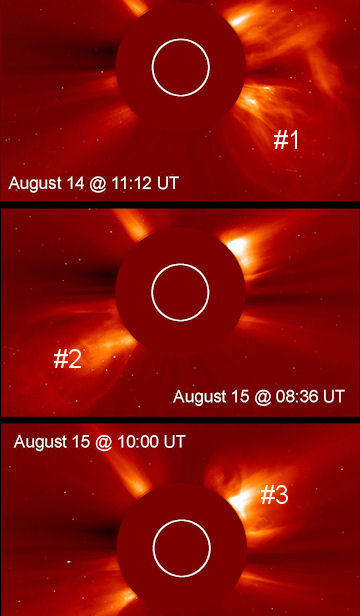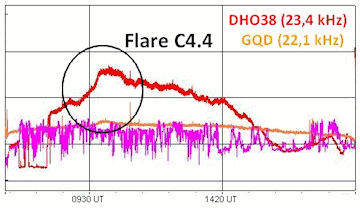iPHONE VS ANDROID! Actually, it doesn't matter which phone you carry. Our cool, new app turns both smartphones into field-tested satellite trackers. Learn more. | | | SPACECRAFT APPROACHES VENUS: A Japanese spacecraft named "Akatsuki" is approaching Venus on a mission that planetary scientists say could end up teaching us a great deal about our own planet Earth. Get the full story from Science@NASA. BANG, BANG, BANG: It was a busy weekend on the sun. Explosions propelled three bright coronal mass ejections (CMEs) into space, shown here in a sequence of coronagraphs from the Solar and Heliospheric Observatory: 
None of the clouds is heading directly toward Earth. CME #1 could deliver a glancing blow to Earth's magnetic field on Aug. 17th. NOAA forecasters estimate a 35% chance of high-latitude geomagnetic activity when the cloud arrives. CMEs #2 and #3, on the other hand, are expected to miss entirely. CME #1 was the end result of a complex eruption involving two sunspot groups (1093 and 1099), a C4-class solar flare, and a lot of magnetic reconnection. NASA's Solar Dynamics Observatory recorded the event in detail. Must-see movies include a close-up and the big picture. IONOSPHERIC DISTURBANCE: The C4-class solar flare of Aug. 14th bathed Earth's upper atmosphere in X-rays and caused a wave of ionization to sweep over Europe. This improved the propagation of low-frequency radio signals which use the ionosphere as a reflector to skip over the horizon. A SID monitor operated by Jan Karlovsky of Hlohovec, Slovakia, recorded the effect: 
"SID" stands for Sudden Ionospheric Disturbance, and a "SID monitor" is a radio receiver that monitors ~20 kHz signals from distant transmitters. "My system easily detected the effects of the solar flare," says Karlovsky. "I monitor two stations: DHO38 in Germany (23.4 kHz) and GQD in Great Britian (22.1 kHz). The German signal was most strongly boosted." With solar activity on the rise, sudden ionospheric disturbances will become more common. Interested? Stanford University tells you how to build your own SID monitor.
UPDATED: 2010 Perseid Photo Gallery
[meteor radar] [Perseid fireball cam]
August 2010 Northern Lights Gallery
[previous Augusts: 2009, 2008, 2007, 2006, 2005, 2004, 2003] | 
